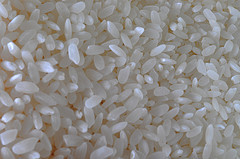Consumer Reports Investigation Finds Arsenic In Variety Of Rice Products
Rice is one flexible little grain. It’s found in cereal (hot and cold), baby food, rice cakes, crackers, pasta, vinegar, syrup, flour and beverages. But a new Consumer Reports study of 60 rice products found varying levels of no one’s favorite ingredient: Arsenic.
The investigation, available at ConsumerReports.org, covered a wide range of rice products and included household brand names like Gerber, Carolina, Goya, Uncle Ben’s, Chex, Rice Krispies, along with store-brand products from chains including Whole Foods, Trader Joe’s, and Walmart.
Every product tested contained some measurable amount of total arsenic, ranging anywhere from 4.6-568 parts per billion. Of greater concern is the number of products that contained inorganic arsenic, a known carcinogen tied to bladder, skin and lung cancer.
Since there is no current federal limit for arsenic in most foods, Consumer Reports took the most stringent state limit on arsenic in drinking water — New Jersey’s at 5 parts per billion — and figured that consuming a liter of such water would expose you to 5 micrograms of inorganic arsenic.
So using 5 micrograms/serving as the threshold, the CR tests found that a majority of the more than 30 rices tested had some results exceeding this number. Some rice samples came back with as high as 9.6 micrograms/serving of inorganic arsenic.
WHAT ABOUT THE CHILDREN?
Of minor relief to parents and caregivers of small children may be the results of the tests on infant cereals. While
all of the samples of the five infant cereal products tested by Consumer Reports did come back positive for inorganic arsenic, none of the samples exceeded the 5 microgram threshold. The infant cereal with the most inorganic arsenic — Earth’s Best Organic Whole Grain Rice — had a high-end result of 2.7 micrograms/serving.
Similarly, neither of the two rice drinks tested by Consumer Reports showed results higher than 4.5 micrograms/serving. However, the folks at CR believe that parents of children under the age of 5 may want to refrain from including rice milk in their kids’ daily diet.
WHERE IS IT COMING FROM?
When looking at the geographic origins of the rice products, CR found that white rice grown in Arkansas, Louisiana, Missouri, and Texas generally had higher levels of total arsenic and inorganic arsenic than rice samples from elsewhere (India, Thailand and California combined).
One of the reasons for the higher levels of arsenic in rice from these states goes back to the days when cotton fields covered the region. Pesticides containing arsenic were used for decades to combat pesky boll weevils.
And even though arsenic can actually reduce rice yields, Andrew Meharg, professor of biogeochemistry at the University of Aberdeen in Scotland and co-author of the book Arsenic & Rice tells Consumer Reports that the Department of Agriculture has invested in research to breed types of rice that can withstand arsenic.
So though the rice may be able to grow in the presence of arsenic, that doesn’t mean the plant contains less arsenic when consumed.
WHAT’S TO BE DONE ABOUT THIS?
This latest arsenic investigation comes less than a year after Consumer Reports found alarming levels of arsenic in apple and other fruit juices. That report eventually resulted in legislation aimed at setting limits on how much arsenic and lead can show up in these drinks.
Thus, Consumer Reports is asking the FDA to set limits for arsenic in rice products. The organization is also pleading to the EPA to phase out the use of pesticides that contain arsenic. CR says the EPA, along with the USDA, could also do folks a service by putting an end to the use of arsenic-laden manure as fertilizer for all foods — oh, and pretty please stop feeding manure to animals.
“Consumers may be surprised to learn that similar to antibiotics, arsenic-containing drugs can be fed daily to chickens, turkeys, and pigs to promote growth, lower the levels of feed required, prevent disease in healthy animals, and color the meat,” explains Urvashi Rangan, Ph.D., Director of Safety and Sustainability at Consumer Reports. “The manure of treated animals ends up containing arsenic too. It can also be used to fertilize food crops, which effectively introduces arsenic back into the food supply. We are asking the government to stop the cycling of arsenic in our food and water.”
Want more consumer news? Visit our parent organization, Consumer Reports, for the latest on scams, recalls, and other consumer issues.


